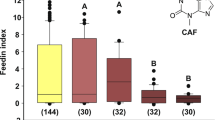Abstract
Recently we reported that monosodium glutamate stimulates feeding in neonates of the codling mothCydia pomonella (L.). Herein we extend our general knowledge about feeding stimulators in neonates of this species, by presenting the effects of several sugars (sucrose, glucose, fructose, and maltose) and non-nutritive sugar substitutes (Sweet’n Low® and Equal®) on consumption of apple leaf (HoneycrispTM) tissue. Glucose, fructose, maltose and aspartame-based Equal had no effect on leaf consumption. Sucrose at a high concentration significantly reduced leaf consumption and delayed commencement of feeding. Sweet’n Low at high concentrations significantly increased leaf consumption and accelerated the commencement of feeding. Saccharin hemicalcium salt was identified as an active ingredient of Sweet’n Low. At 500 ppm and 1000 ppm, saccharin hemicalcium salt increased leaf consumption and accelerated commencement of feeding. The practical aspects of our findings are discussed.
Similar content being viewed by others
References
Baker, J.E. and Mabie, J.A. (1973) Feeding behavior of larvae ofPlodia interpunctella.Environ. Entomol. 2:627–632.
Bartelt, J.R., McGuire, M.R. and Black, D.A. (1990) Feeding stimulants for the European corn borer (Lepidoptera:Pyralidae): additives to a starch-based formulation forBacillus thuringiensis.Environ. Entomol. 19:182–189.
Beck, S.D. (1957) The European corn borer,Pyrausta nubilalis (Hübn.) and its principal host plant. IV. Larval saccharotrophism and host plants resistance.Ann. Entomol. Soc. Am. 50:247–250.
Bell, M.R. and Romine, C.L. (1980) Tobacco budworm field evaluation of microbial control in cotton usingBacillus thuringiensis and nuclear polyhedrosis virus, with a feeding adjuvant.J. Econ. Entomol. 73:427–430.
Brownbridge, M. (1993) Feeding stimulation inChilo partellus (Swinhoe) (Lepidoptera: Pyralidae) larvae by some commonly available sugars and its effect on larval mortality caused byBacillus thuringiensis (Berliner).Insect Sci. Appl. 14:465–470.
Charmillot, P-J., Hofer, D. and Pasquier, D. (2000) Attract and kill: a new method for control of the codling mothCydia pomonella.Entomol. Exp. Appl. 94:211–216.
Cobbinah, J.R., Morgan, F.D. and Douglas, T.J. (1982) Feeding responses of the gum leaf skeletonistUraba lugens Walker, to sugars, amino acids, lipids, sterols, salts, vitamins and certain extracts of eucalypt leaves.J. Aust. Entomol. Soc. 21:225–236.
Gothlif, S. and Beck, S.D. (1967) Larval feeding behavior of the cabbage looper,Trichoplusia ni. J. Insect Physiol. 13:1039–1054.
Hafez, M., Salama, H.S., Aboul Elal, R.G. and Ragaeil, M. (1987) Evaluation of adjuvants for use withBacillus thuringiensis againstHeliothis armigera (Hübn.).J. Appl. Entomol. 103:313–319.
Heron, R.J. (1965) The role of chemotactic stimuli in the feeding behavior of spruce budworm larvae on white spruce.Can. J. Zool. 43:247–269.
Howell, J.F., Knight, A.L., Unruh, T.R., Brown, D.F., Krysan, J.L., Sell, C.R.et al. (1992) Control of codling moth in apple and pear with sex pheromone-mediated mating disruption.J. Econ. Entomol. 85:918–925.
Ito, T. (1960) Effect of sugars on feeding of larvae of the silkworm,Bombyx mori.J. Insect Physiol. 5:95–107.
Johnson, D.R. (1982) Suppression ofHeliothis spp. on cotton by usingBacillus thuringiensis, Baculovirus heliothis, and two feeding adjuvants.J. Econ. Entomol. 75:207–210.
Jones, R.L., McMillan, W.W. and Wiseman, B.R. (1972) Chemicals in kernels of corn that elicit a feeding response from larvae of the corn earworm.Ann. Entomol. Soc. Am. 65:821–824.
Ma, W.C. and Kubo, I. (1977) Phagostimulants forSpodoptera exempta: identification of adenosine fromZea mays.Entomol. Exp. Appl. 22:107–112.
Meisner, J., Ascher, K.R.S. and Flowers, H.M. (1972) The feeding response of the larvae of the Egyptian cotton leafworm,Spodoptera littoralis Boisd., to sugars and related compounds. I. Phagostimulatory and deterrent effects.Comp. Biochem. Physiol. 42A:899–914.
Meisner, J., Ascher, K.R.S. and Lavie, D. (1974) Phagostimulants for the larva of the potato tuber moth,Gnorimoschema operculella Zell.Z. Angew. Entomol. 77:67–91.
Meisner, J., Hadar, D., Wysoki, M. and Harpaz, I. (1990) Phagostimulants enhancing the efficacy ofBacillus thuringiensis formulations against the giant looper,Boarmia (Ascotis) selenaria, in avocado.Phytoparasitica 18:107–115.
Merkel, A.D., Wayner, M.J., Jolicoeur, F.B. and Mintz, R.B. (1979) Effects of glucose and saccharin solutions on subsequent food consumption.Physiol. Behav. 23:791–793.
Pszczolkowski, M.A. and Brown, J.J. (2002) Prospects of monosodium glutamate use for enhancement of spinosad toxicity against codling moth neonates.Phytoparasitica 30:243–252.
Pszczolkowski, M.A., Matos, L.F., Zahand, A. and Brown, J.J. (2002) Effect of monosodium glutamate on apple leaf consumption by codling moth larvae.Entomol. Exp. Appl. 103:91–98.
Pszczolkowski, M.A., Zahand, A., Bushman, S.M. and Brown, J.J. (2003) Effects of calcium and glutamate receptor agonists on leaf consumption by lepidopteran neonates.Pharmacol. Biochem. Behav. 74:389–394.
Rogers, P.J. and Blundell, J.E. (1989) Separating the action of sweetness and calories: Effects of saccharin and carbohydrates on hunger and food intake in human beings.Physiol. Behav. 45:1093–1099.
Schiff, N.M., Waldbauer, G.B. and Friedman, S. (1990) Gustatory insensitivity of two insect species to L-aspartyl-L-phenylalanyl methyl ester (aspartame).Entomol. Exp. Appl. 54:189–190.
Tordoff, M.G. and Friedman, M.I. (1989) Drinking saccharin increases food intake and preference. I. Comparison with other drinks.Appetite 12:1–10.
Yamamoto, R.T. and Fraenkel, G. (1960) Assay of the principal gustatory stimulants for the tobacco hornworm,Protoparce sexta, from solanaceous plants.Ann. Entomol. Soc. Am. 53:499–503.
Author information
Authors and Affiliations
Corresponding author
Additional information
http://www.phytoparasitica.org posting May 6, 2003.
Rights and permissions
About this article
Cite this article
Pszczolkowski, M.A., Brown, J.J. Effect of sugars and non-nutritive sugar substitutes on consumption of apple leaves by codling moth neonates. Phytoparasitica 31, 283–291 (2003). https://doi.org/10.1007/BF02980837
Received:
Revised:
Issue Date:
DOI: https://doi.org/10.1007/BF02980837




